Dementia Care and Management Strategies
VerifiedAdded on 2020/03/04
|16
|4195
|66
AI Summary
The assignment delves into the multifaceted aspects of dementia care and management. It presents a range of treatment options for dementia, encompassing both pharmacological interventions like tandospirone and non-pharmacological strategies such as electronic apps designed to assist clinicians. The discussion highlights the importance of person-centered care, particularly for older veterans with dementia. Furthermore, it analyzes the challenges associated with providing high-quality, integrated dementia care in community settings and emphasizes the roles of family physicians and specialists in addressing these complexities.
Contribute Materials
Your contribution can guide someone’s learning journey. Share your
documents today.

Running head: MENTAL HEALTH
Mental health
Name of the student:
Name of the university:
Author note:
Mental health
Name of the student:
Name of the university:
Author note:
Secure Best Marks with AI Grader
Need help grading? Try our AI Grader for instant feedback on your assignments.
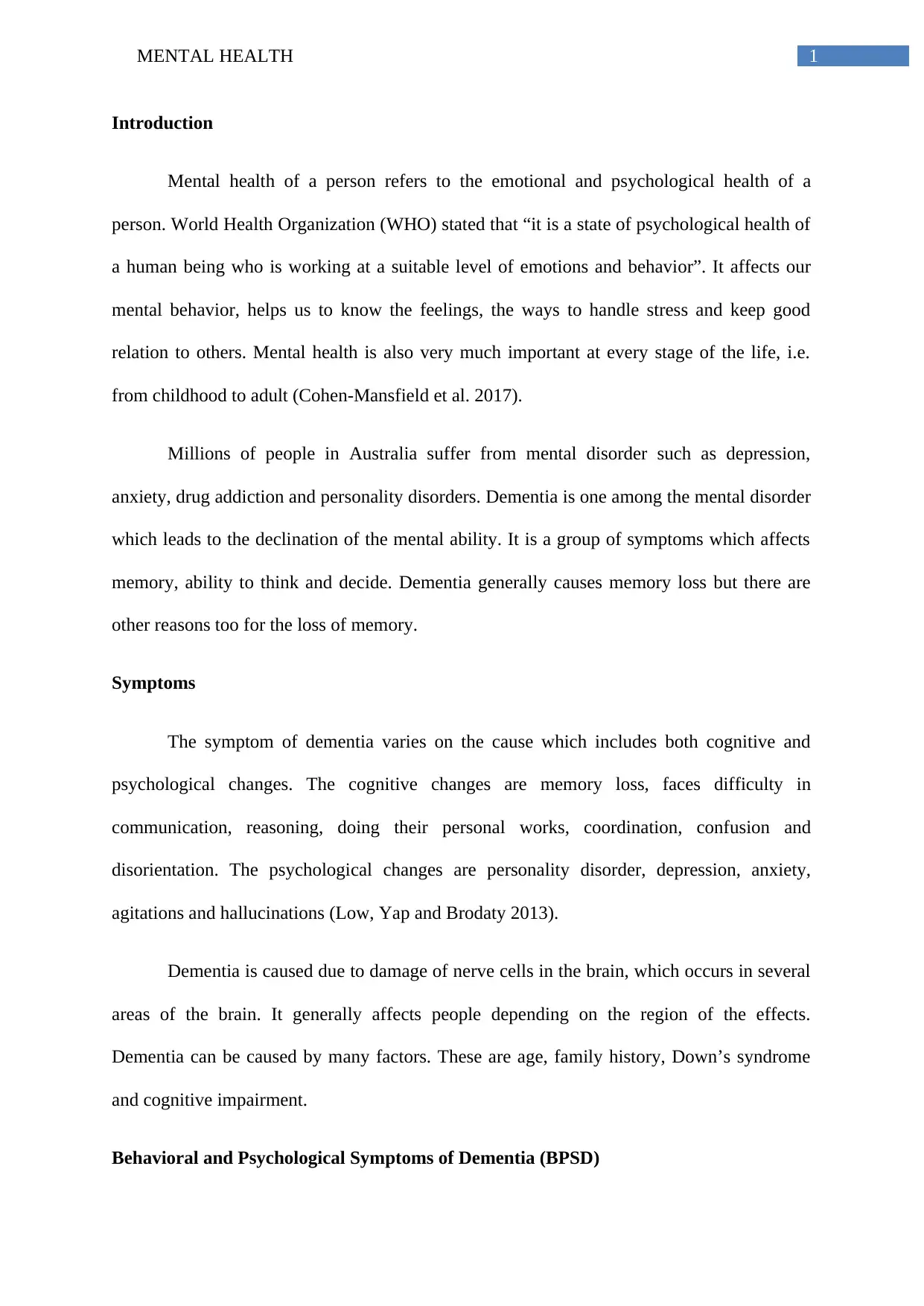
1MENTAL HEALTH
Introduction
Mental health of a person refers to the emotional and psychological health of a
person. World Health Organization (WHO) stated that “it is a state of psychological health of
a human being who is working at a suitable level of emotions and behavior”. It affects our
mental behavior, helps us to know the feelings, the ways to handle stress and keep good
relation to others. Mental health is also very much important at every stage of the life, i.e.
from childhood to adult (Cohen-Mansfield et al. 2017).
Millions of people in Australia suffer from mental disorder such as depression,
anxiety, drug addiction and personality disorders. Dementia is one among the mental disorder
which leads to the declination of the mental ability. It is a group of symptoms which affects
memory, ability to think and decide. Dementia generally causes memory loss but there are
other reasons too for the loss of memory.
Symptoms
The symptom of dementia varies on the cause which includes both cognitive and
psychological changes. The cognitive changes are memory loss, faces difficulty in
communication, reasoning, doing their personal works, coordination, confusion and
disorientation. The psychological changes are personality disorder, depression, anxiety,
agitations and hallucinations (Low, Yap and Brodaty 2013).
Dementia is caused due to damage of nerve cells in the brain, which occurs in several
areas of the brain. It generally affects people depending on the region of the effects.
Dementia can be caused by many factors. These are age, family history, Down’s syndrome
and cognitive impairment.
Behavioral and Psychological Symptoms of Dementia (BPSD)
Introduction
Mental health of a person refers to the emotional and psychological health of a
person. World Health Organization (WHO) stated that “it is a state of psychological health of
a human being who is working at a suitable level of emotions and behavior”. It affects our
mental behavior, helps us to know the feelings, the ways to handle stress and keep good
relation to others. Mental health is also very much important at every stage of the life, i.e.
from childhood to adult (Cohen-Mansfield et al. 2017).
Millions of people in Australia suffer from mental disorder such as depression,
anxiety, drug addiction and personality disorders. Dementia is one among the mental disorder
which leads to the declination of the mental ability. It is a group of symptoms which affects
memory, ability to think and decide. Dementia generally causes memory loss but there are
other reasons too for the loss of memory.
Symptoms
The symptom of dementia varies on the cause which includes both cognitive and
psychological changes. The cognitive changes are memory loss, faces difficulty in
communication, reasoning, doing their personal works, coordination, confusion and
disorientation. The psychological changes are personality disorder, depression, anxiety,
agitations and hallucinations (Low, Yap and Brodaty 2013).
Dementia is caused due to damage of nerve cells in the brain, which occurs in several
areas of the brain. It generally affects people depending on the region of the effects.
Dementia can be caused by many factors. These are age, family history, Down’s syndrome
and cognitive impairment.
Behavioral and Psychological Symptoms of Dementia (BPSD)
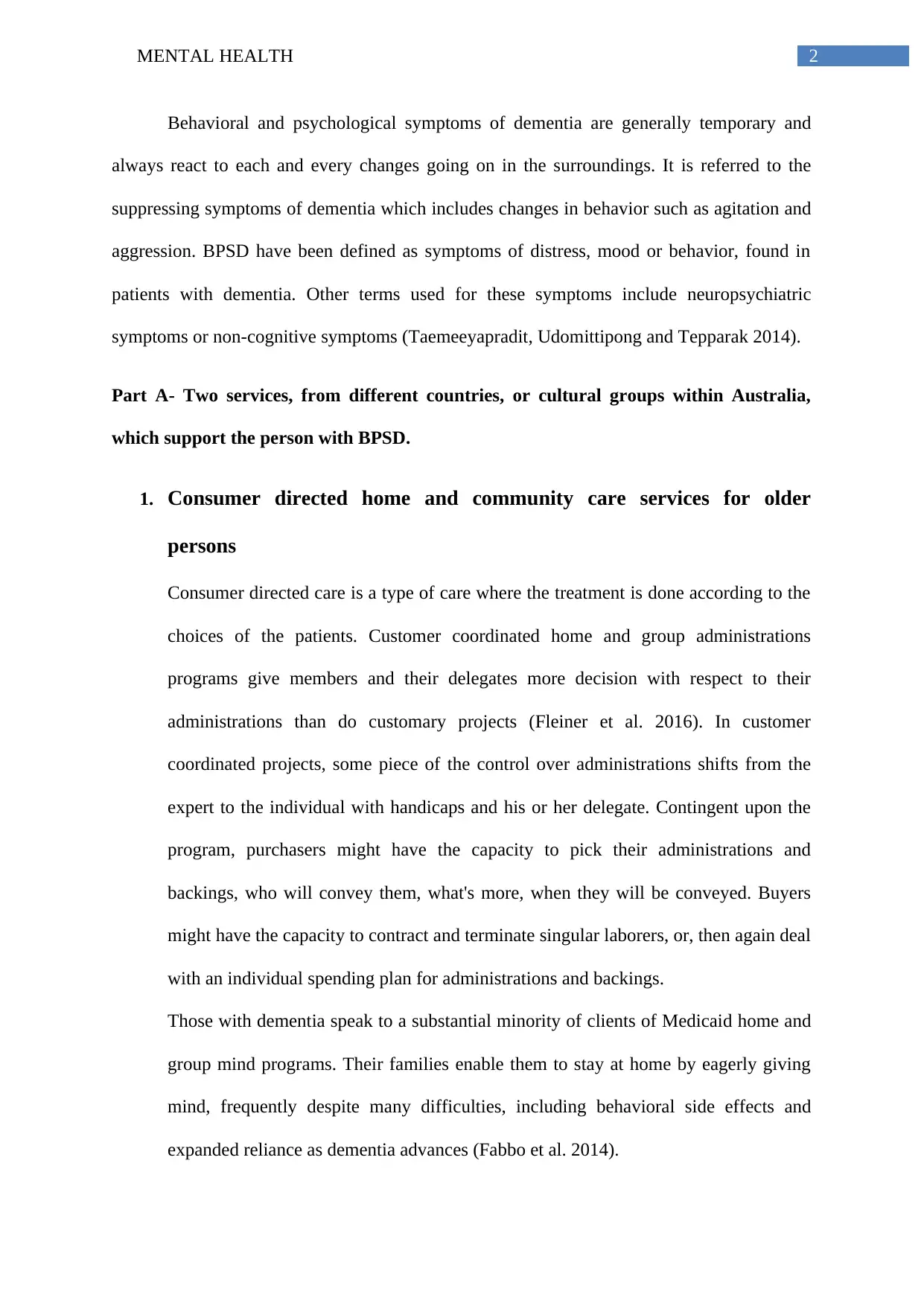
2MENTAL HEALTH
Behavioral and psychological symptoms of dementia are generally temporary and
always react to each and every changes going on in the surroundings. It is referred to the
suppressing symptoms of dementia which includes changes in behavior such as agitation and
aggression. BPSD have been defined as symptoms of distress, mood or behavior, found in
patients with dementia. Other terms used for these symptoms include neuropsychiatric
symptoms or non-cognitive symptoms (Taemeeyapradit, Udomittipong and Tepparak 2014).
Part A- Two services, from different countries, or cultural groups within Australia,
which support the person with BPSD.
1. Consumer directed home and community care services for older
persons
Consumer directed care is a type of care where the treatment is done according to the
choices of the patients. Customer coordinated home and group administrations
programs give members and their delegates more decision with respect to their
administrations than do customary projects (Fleiner et al. 2016). In customer
coordinated projects, some piece of the control over administrations shifts from the
expert to the individual with handicaps and his or her delegate. Contingent upon the
program, purchasers might have the capacity to pick their administrations and
backings, who will convey them, what's more, when they will be conveyed. Buyers
might have the capacity to contract and terminate singular laborers, or, then again deal
with an individual spending plan for administrations and backings.
Those with dementia speak to a substantial minority of clients of Medicaid home and
group mind programs. Their families enable them to stay at home by eagerly giving
mind, frequently despite many difficulties, including behavioral side effects and
expanded reliance as dementia advances (Fabbo et al. 2014).
Behavioral and psychological symptoms of dementia are generally temporary and
always react to each and every changes going on in the surroundings. It is referred to the
suppressing symptoms of dementia which includes changes in behavior such as agitation and
aggression. BPSD have been defined as symptoms of distress, mood or behavior, found in
patients with dementia. Other terms used for these symptoms include neuropsychiatric
symptoms or non-cognitive symptoms (Taemeeyapradit, Udomittipong and Tepparak 2014).
Part A- Two services, from different countries, or cultural groups within Australia,
which support the person with BPSD.
1. Consumer directed home and community care services for older
persons
Consumer directed care is a type of care where the treatment is done according to the
choices of the patients. Customer coordinated home and group administrations
programs give members and their delegates more decision with respect to their
administrations than do customary projects (Fleiner et al. 2016). In customer
coordinated projects, some piece of the control over administrations shifts from the
expert to the individual with handicaps and his or her delegate. Contingent upon the
program, purchasers might have the capacity to pick their administrations and
backings, who will convey them, what's more, when they will be conveyed. Buyers
might have the capacity to contract and terminate singular laborers, or, then again deal
with an individual spending plan for administrations and backings.
Those with dementia speak to a substantial minority of clients of Medicaid home and
group mind programs. Their families enable them to stay at home by eagerly giving
mind, frequently despite many difficulties, including behavioral side effects and
expanded reliance as dementia advances (Fabbo et al. 2014).
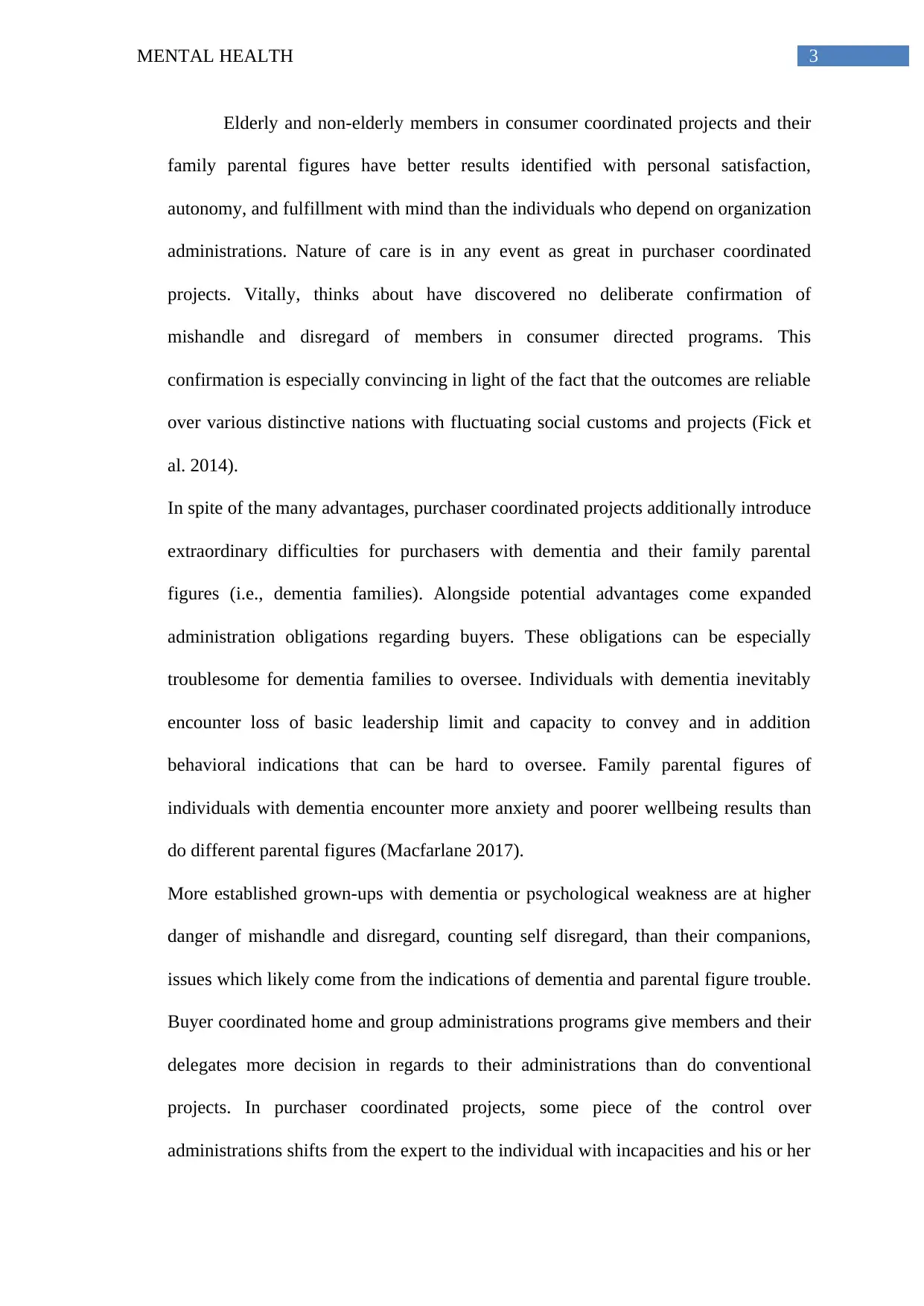
3MENTAL HEALTH
Elderly and non-elderly members in consumer coordinated projects and their
family parental figures have better results identified with personal satisfaction,
autonomy, and fulfillment with mind than the individuals who depend on organization
administrations. Nature of care is in any event as great in purchaser coordinated
projects. Vitally, thinks about have discovered no deliberate confirmation of
mishandle and disregard of members in consumer directed programs. This
confirmation is especially convincing in light of the fact that the outcomes are reliable
over various distinctive nations with fluctuating social customs and projects (Fick et
al. 2014).
In spite of the many advantages, purchaser coordinated projects additionally introduce
extraordinary difficulties for purchasers with dementia and their family parental
figures (i.e., dementia families). Alongside potential advantages come expanded
administration obligations regarding buyers. These obligations can be especially
troublesome for dementia families to oversee. Individuals with dementia inevitably
encounter loss of basic leadership limit and capacity to convey and in addition
behavioral indications that can be hard to oversee. Family parental figures of
individuals with dementia encounter more anxiety and poorer wellbeing results than
do different parental figures (Macfarlane 2017).
More established grown-ups with dementia or psychological weakness are at higher
danger of mishandle and disregard, counting self disregard, than their companions,
issues which likely come from the indications of dementia and parental figure trouble.
Buyer coordinated home and group administrations programs give members and their
delegates more decision in regards to their administrations than do conventional
projects. In purchaser coordinated projects, some piece of the control over
administrations shifts from the expert to the individual with incapacities and his or her
Elderly and non-elderly members in consumer coordinated projects and their
family parental figures have better results identified with personal satisfaction,
autonomy, and fulfillment with mind than the individuals who depend on organization
administrations. Nature of care is in any event as great in purchaser coordinated
projects. Vitally, thinks about have discovered no deliberate confirmation of
mishandle and disregard of members in consumer directed programs. This
confirmation is especially convincing in light of the fact that the outcomes are reliable
over various distinctive nations with fluctuating social customs and projects (Fick et
al. 2014).
In spite of the many advantages, purchaser coordinated projects additionally introduce
extraordinary difficulties for purchasers with dementia and their family parental
figures (i.e., dementia families). Alongside potential advantages come expanded
administration obligations regarding buyers. These obligations can be especially
troublesome for dementia families to oversee. Individuals with dementia inevitably
encounter loss of basic leadership limit and capacity to convey and in addition
behavioral indications that can be hard to oversee. Family parental figures of
individuals with dementia encounter more anxiety and poorer wellbeing results than
do different parental figures (Macfarlane 2017).
More established grown-ups with dementia or psychological weakness are at higher
danger of mishandle and disregard, counting self disregard, than their companions,
issues which likely come from the indications of dementia and parental figure trouble.
Buyer coordinated home and group administrations programs give members and their
delegates more decision in regards to their administrations than do conventional
projects. In purchaser coordinated projects, some piece of the control over
administrations shifts from the expert to the individual with incapacities and his or her
Secure Best Marks with AI Grader
Need help grading? Try our AI Grader for instant feedback on your assignments.
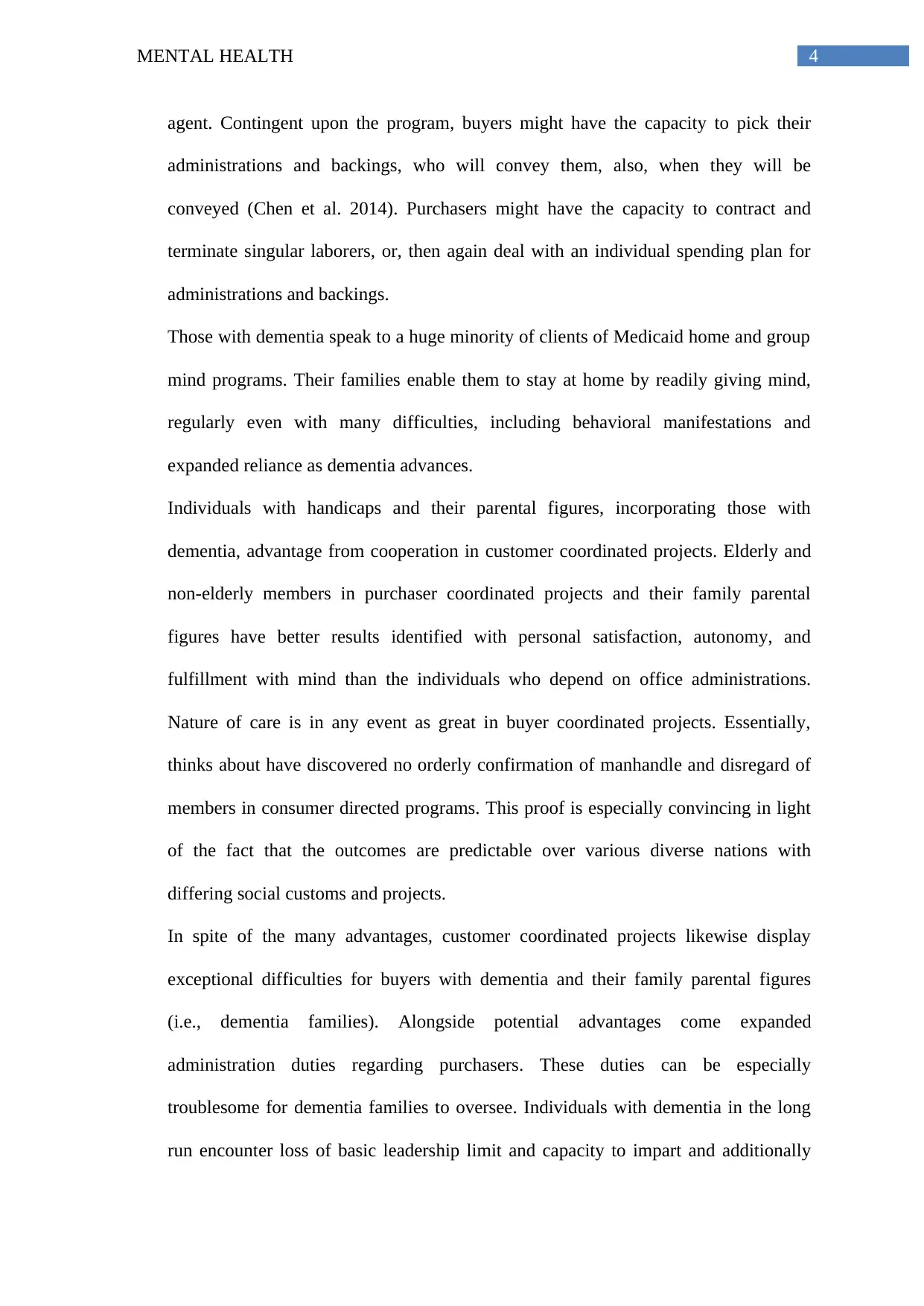
4MENTAL HEALTH
agent. Contingent upon the program, buyers might have the capacity to pick their
administrations and backings, who will convey them, also, when they will be
conveyed (Chen et al. 2014). Purchasers might have the capacity to contract and
terminate singular laborers, or, then again deal with an individual spending plan for
administrations and backings.
Those with dementia speak to a huge minority of clients of Medicaid home and group
mind programs. Their families enable them to stay at home by readily giving mind,
regularly even with many difficulties, including behavioral manifestations and
expanded reliance as dementia advances.
Individuals with handicaps and their parental figures, incorporating those with
dementia, advantage from cooperation in customer coordinated projects. Elderly and
non-elderly members in purchaser coordinated projects and their family parental
figures have better results identified with personal satisfaction, autonomy, and
fulfillment with mind than the individuals who depend on office administrations.
Nature of care is in any event as great in buyer coordinated projects. Essentially,
thinks about have discovered no orderly confirmation of manhandle and disregard of
members in consumer directed programs. This proof is especially convincing in light
of the fact that the outcomes are predictable over various diverse nations with
differing social customs and projects.
In spite of the many advantages, customer coordinated projects likewise display
exceptional difficulties for buyers with dementia and their family parental figures
(i.e., dementia families). Alongside potential advantages come expanded
administration duties regarding purchasers. These duties can be especially
troublesome for dementia families to oversee. Individuals with dementia in the long
run encounter loss of basic leadership limit and capacity to impart and additionally
agent. Contingent upon the program, buyers might have the capacity to pick their
administrations and backings, who will convey them, also, when they will be
conveyed (Chen et al. 2014). Purchasers might have the capacity to contract and
terminate singular laborers, or, then again deal with an individual spending plan for
administrations and backings.
Those with dementia speak to a huge minority of clients of Medicaid home and group
mind programs. Their families enable them to stay at home by readily giving mind,
regularly even with many difficulties, including behavioral manifestations and
expanded reliance as dementia advances.
Individuals with handicaps and their parental figures, incorporating those with
dementia, advantage from cooperation in customer coordinated projects. Elderly and
non-elderly members in purchaser coordinated projects and their family parental
figures have better results identified with personal satisfaction, autonomy, and
fulfillment with mind than the individuals who depend on office administrations.
Nature of care is in any event as great in buyer coordinated projects. Essentially,
thinks about have discovered no orderly confirmation of manhandle and disregard of
members in consumer directed programs. This proof is especially convincing in light
of the fact that the outcomes are predictable over various diverse nations with
differing social customs and projects.
In spite of the many advantages, customer coordinated projects likewise display
exceptional difficulties for buyers with dementia and their family parental figures
(i.e., dementia families). Alongside potential advantages come expanded
administration duties regarding purchasers. These duties can be especially
troublesome for dementia families to oversee. Individuals with dementia in the long
run encounter loss of basic leadership limit and capacity to impart and additionally
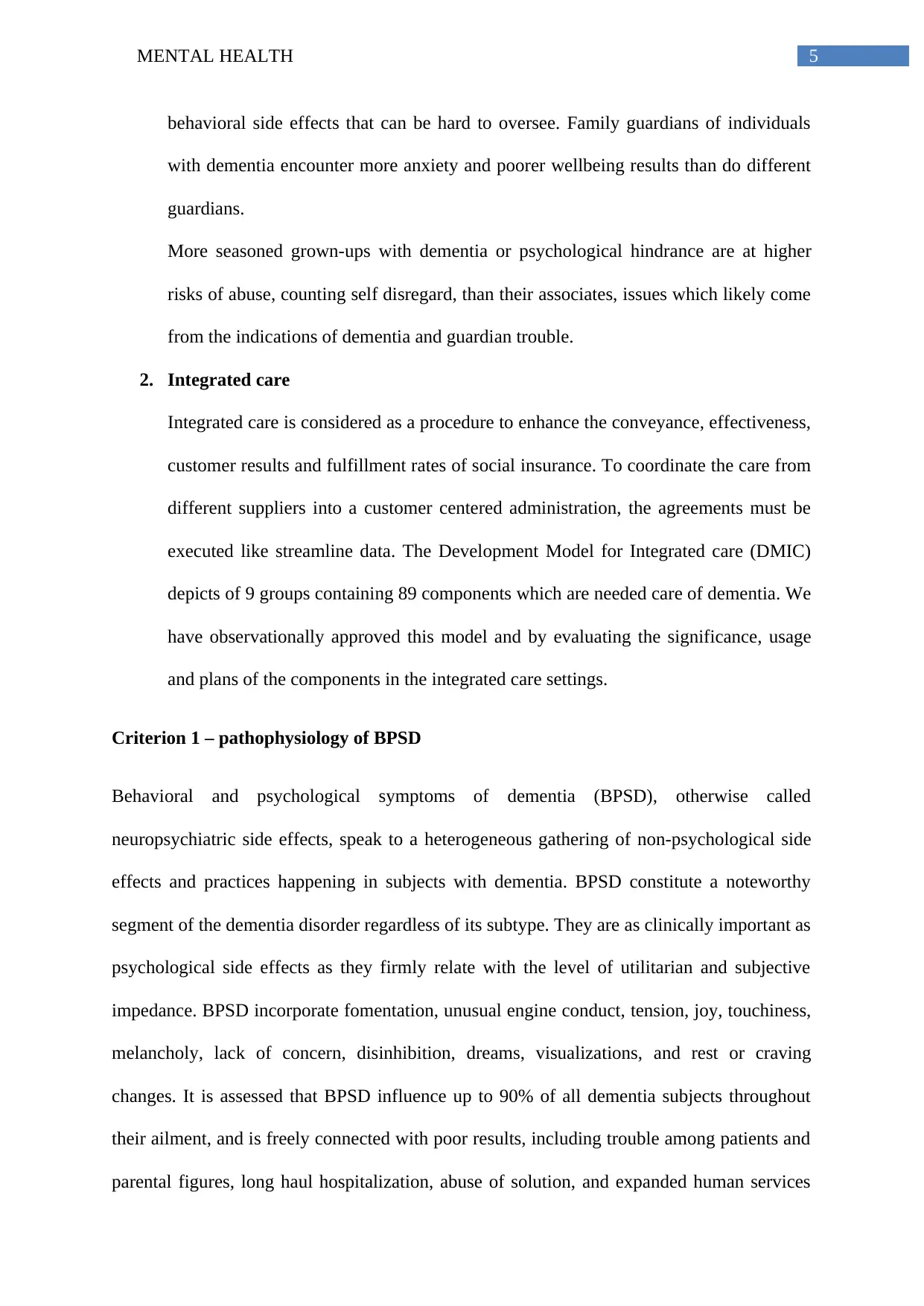
5MENTAL HEALTH
behavioral side effects that can be hard to oversee. Family guardians of individuals
with dementia encounter more anxiety and poorer wellbeing results than do different
guardians.
More seasoned grown-ups with dementia or psychological hindrance are at higher
risks of abuse, counting self disregard, than their associates, issues which likely come
from the indications of dementia and guardian trouble.
2. Integrated care
Integrated care is considered as a procedure to enhance the conveyance, effectiveness,
customer results and fulfillment rates of social insurance. To coordinate the care from
different suppliers into a customer centered administration, the agreements must be
executed like streamline data. The Development Model for Integrated care (DMIC)
depicts of 9 groups containing 89 components which are needed care of dementia. We
have observationally approved this model and by evaluating the significance, usage
and plans of the components in the integrated care settings.
Criterion 1 – pathophysiology of BPSD
Behavioral and psychological symptoms of dementia (BPSD), otherwise called
neuropsychiatric side effects, speak to a heterogeneous gathering of non-psychological side
effects and practices happening in subjects with dementia. BPSD constitute a noteworthy
segment of the dementia disorder regardless of its subtype. They are as clinically important as
psychological side effects as they firmly relate with the level of utilitarian and subjective
impedance. BPSD incorporate fomentation, unusual engine conduct, tension, joy, touchiness,
melancholy, lack of concern, disinhibition, dreams, visualizations, and rest or craving
changes. It is assessed that BPSD influence up to 90% of all dementia subjects throughout
their ailment, and is freely connected with poor results, including trouble among patients and
parental figures, long haul hospitalization, abuse of solution, and expanded human services
behavioral side effects that can be hard to oversee. Family guardians of individuals
with dementia encounter more anxiety and poorer wellbeing results than do different
guardians.
More seasoned grown-ups with dementia or psychological hindrance are at higher
risks of abuse, counting self disregard, than their associates, issues which likely come
from the indications of dementia and guardian trouble.
2. Integrated care
Integrated care is considered as a procedure to enhance the conveyance, effectiveness,
customer results and fulfillment rates of social insurance. To coordinate the care from
different suppliers into a customer centered administration, the agreements must be
executed like streamline data. The Development Model for Integrated care (DMIC)
depicts of 9 groups containing 89 components which are needed care of dementia. We
have observationally approved this model and by evaluating the significance, usage
and plans of the components in the integrated care settings.
Criterion 1 – pathophysiology of BPSD
Behavioral and psychological symptoms of dementia (BPSD), otherwise called
neuropsychiatric side effects, speak to a heterogeneous gathering of non-psychological side
effects and practices happening in subjects with dementia. BPSD constitute a noteworthy
segment of the dementia disorder regardless of its subtype. They are as clinically important as
psychological side effects as they firmly relate with the level of utilitarian and subjective
impedance. BPSD incorporate fomentation, unusual engine conduct, tension, joy, touchiness,
melancholy, lack of concern, disinhibition, dreams, visualizations, and rest or craving
changes. It is assessed that BPSD influence up to 90% of all dementia subjects throughout
their ailment, and is freely connected with poor results, including trouble among patients and
parental figures, long haul hospitalization, abuse of solution, and expanded human services
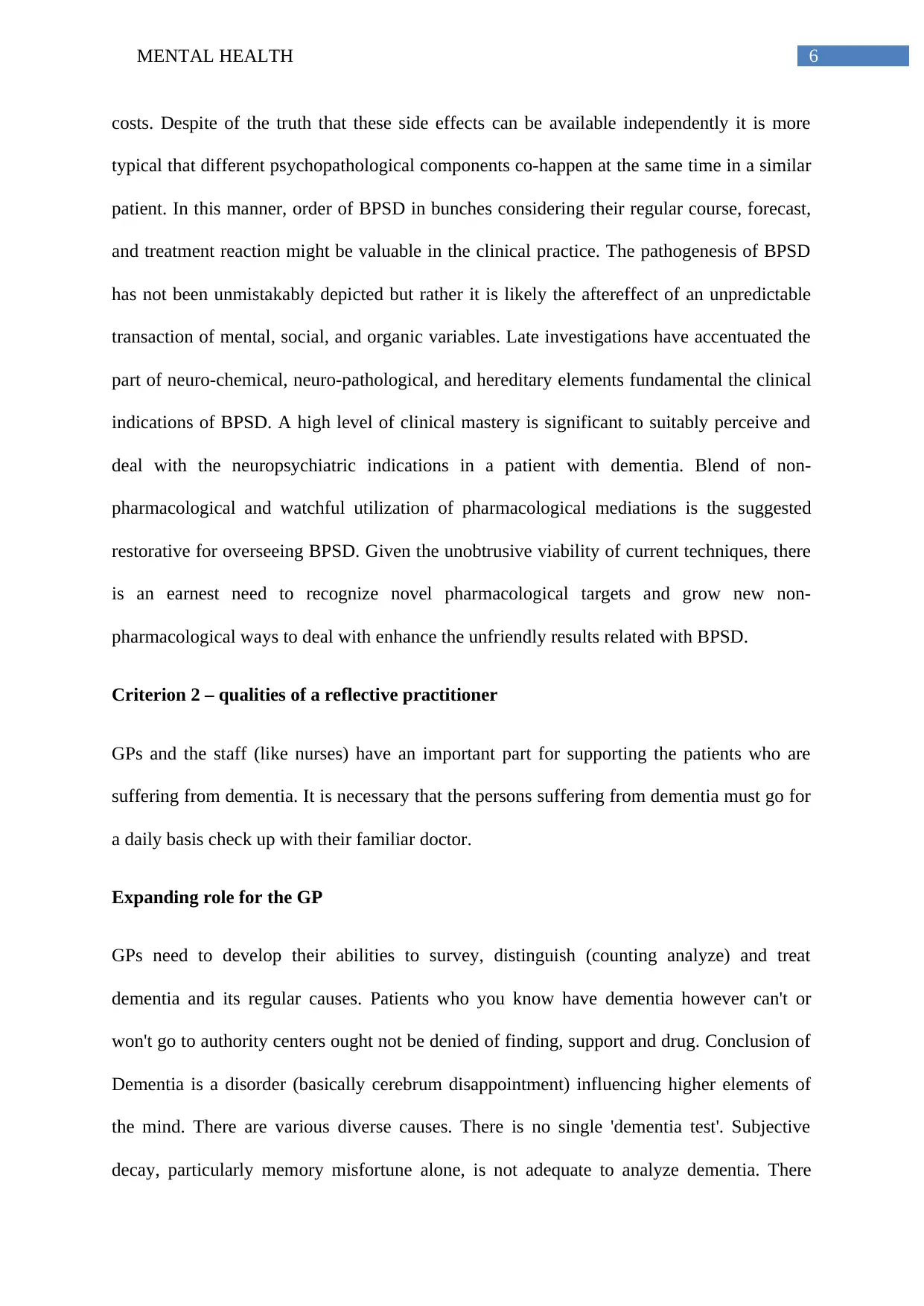
6MENTAL HEALTH
costs. Despite of the truth that these side effects can be available independently it is more
typical that different psychopathological components co-happen at the same time in a similar
patient. In this manner, order of BPSD in bunches considering their regular course, forecast,
and treatment reaction might be valuable in the clinical practice. The pathogenesis of BPSD
has not been unmistakably depicted but rather it is likely the aftereffect of an unpredictable
transaction of mental, social, and organic variables. Late investigations have accentuated the
part of neuro-chemical, neuro-pathological, and hereditary elements fundamental the clinical
indications of BPSD. A high level of clinical mastery is significant to suitably perceive and
deal with the neuropsychiatric indications in a patient with dementia. Blend of non-
pharmacological and watchful utilization of pharmacological mediations is the suggested
restorative for overseeing BPSD. Given the unobtrusive viability of current techniques, there
is an earnest need to recognize novel pharmacological targets and grow new non-
pharmacological ways to deal with enhance the unfriendly results related with BPSD.
Criterion 2 – qualities of a reflective practitioner
GPs and the staff (like nurses) have an important part for supporting the patients who are
suffering from dementia. It is necessary that the persons suffering from dementia must go for
a daily basis check up with their familiar doctor.
Expanding role for the GP
GPs need to develop their abilities to survey, distinguish (counting analyze) and treat
dementia and its regular causes. Patients who you know have dementia however can't or
won't go to authority centers ought not be denied of finding, support and drug. Conclusion of
Dementia is a disorder (basically cerebrum disappointment) influencing higher elements of
the mind. There are various diverse causes. There is no single 'dementia test'. Subjective
decay, particularly memory misfortune alone, is not adequate to analyze dementia. There
costs. Despite of the truth that these side effects can be available independently it is more
typical that different psychopathological components co-happen at the same time in a similar
patient. In this manner, order of BPSD in bunches considering their regular course, forecast,
and treatment reaction might be valuable in the clinical practice. The pathogenesis of BPSD
has not been unmistakably depicted but rather it is likely the aftereffect of an unpredictable
transaction of mental, social, and organic variables. Late investigations have accentuated the
part of neuro-chemical, neuro-pathological, and hereditary elements fundamental the clinical
indications of BPSD. A high level of clinical mastery is significant to suitably perceive and
deal with the neuropsychiatric indications in a patient with dementia. Blend of non-
pharmacological and watchful utilization of pharmacological mediations is the suggested
restorative for overseeing BPSD. Given the unobtrusive viability of current techniques, there
is an earnest need to recognize novel pharmacological targets and grow new non-
pharmacological ways to deal with enhance the unfriendly results related with BPSD.
Criterion 2 – qualities of a reflective practitioner
GPs and the staff (like nurses) have an important part for supporting the patients who are
suffering from dementia. It is necessary that the persons suffering from dementia must go for
a daily basis check up with their familiar doctor.
Expanding role for the GP
GPs need to develop their abilities to survey, distinguish (counting analyze) and treat
dementia and its regular causes. Patients who you know have dementia however can't or
won't go to authority centers ought not be denied of finding, support and drug. Conclusion of
Dementia is a disorder (basically cerebrum disappointment) influencing higher elements of
the mind. There are various diverse causes. There is no single 'dementia test'. Subjective
decay, particularly memory misfortune alone, is not adequate to analyze dementia. There
Paraphrase This Document
Need a fresh take? Get an instant paraphrase of this document with our AI Paraphraser
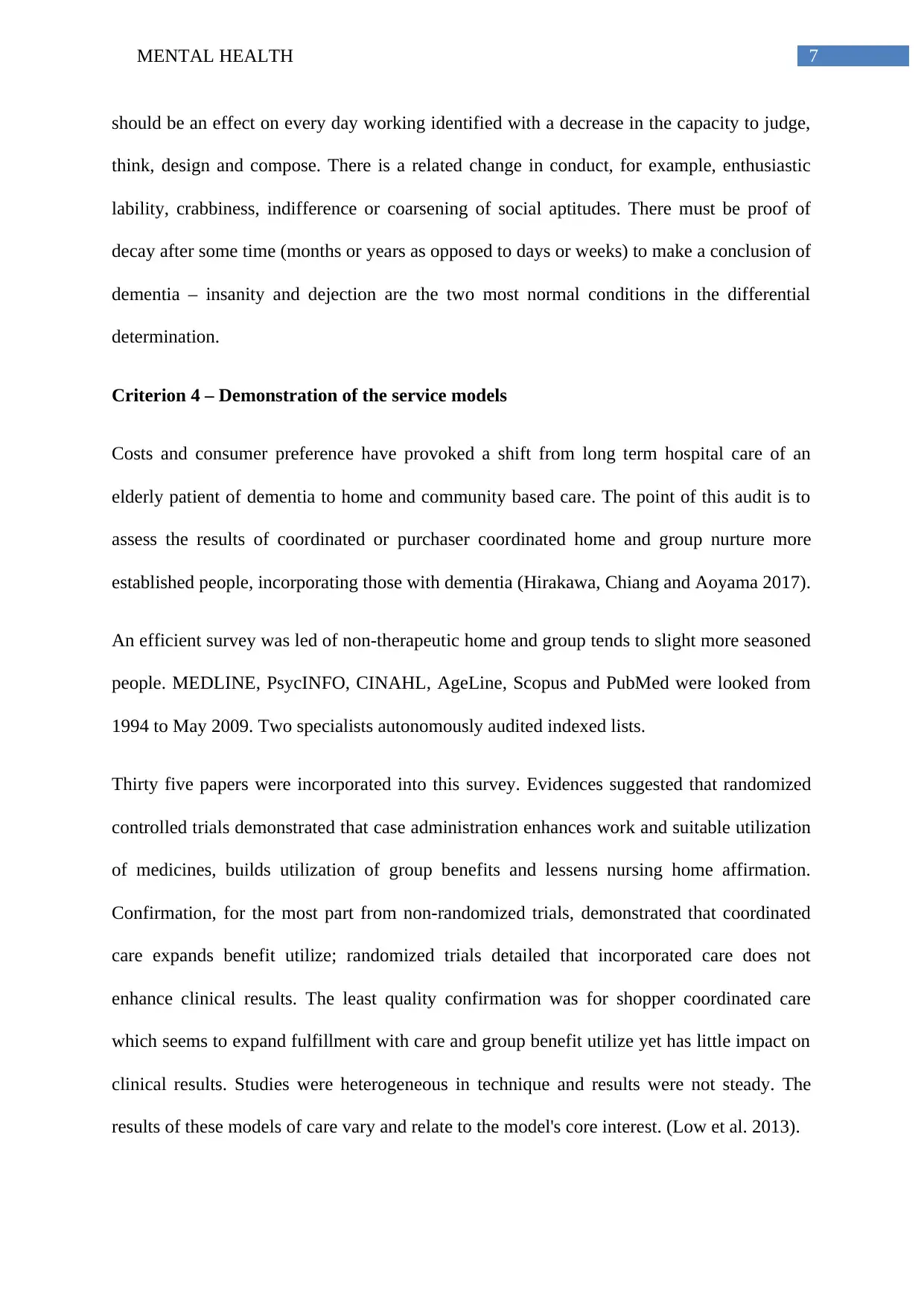
7MENTAL HEALTH
should be an effect on every day working identified with a decrease in the capacity to judge,
think, design and compose. There is a related change in conduct, for example, enthusiastic
lability, crabbiness, indifference or coarsening of social aptitudes. There must be proof of
decay after some time (months or years as opposed to days or weeks) to make a conclusion of
dementia – insanity and dejection are the two most normal conditions in the differential
determination.
Criterion 4 – Demonstration of the service models
Costs and consumer preference have provoked a shift from long term hospital care of an
elderly patient of dementia to home and community based care. The point of this audit is to
assess the results of coordinated or purchaser coordinated home and group nurture more
established people, incorporating those with dementia (Hirakawa, Chiang and Aoyama 2017).
An efficient survey was led of non-therapeutic home and group tends to slight more seasoned
people. MEDLINE, PsycINFO, CINAHL, AgeLine, Scopus and PubMed were looked from
1994 to May 2009. Two specialists autonomously audited indexed lists.
Thirty five papers were incorporated into this survey. Evidences suggested that randomized
controlled trials demonstrated that case administration enhances work and suitable utilization
of medicines, builds utilization of group benefits and lessens nursing home affirmation.
Confirmation, for the most part from non-randomized trials, demonstrated that coordinated
care expands benefit utilize; randomized trials detailed that incorporated care does not
enhance clinical results. The least quality confirmation was for shopper coordinated care
which seems to expand fulfillment with care and group benefit utilize yet has little impact on
clinical results. Studies were heterogeneous in technique and results were not steady. The
results of these models of care vary and relate to the model's core interest. (Low et al. 2013).
should be an effect on every day working identified with a decrease in the capacity to judge,
think, design and compose. There is a related change in conduct, for example, enthusiastic
lability, crabbiness, indifference or coarsening of social aptitudes. There must be proof of
decay after some time (months or years as opposed to days or weeks) to make a conclusion of
dementia – insanity and dejection are the two most normal conditions in the differential
determination.
Criterion 4 – Demonstration of the service models
Costs and consumer preference have provoked a shift from long term hospital care of an
elderly patient of dementia to home and community based care. The point of this audit is to
assess the results of coordinated or purchaser coordinated home and group nurture more
established people, incorporating those with dementia (Hirakawa, Chiang and Aoyama 2017).
An efficient survey was led of non-therapeutic home and group tends to slight more seasoned
people. MEDLINE, PsycINFO, CINAHL, AgeLine, Scopus and PubMed were looked from
1994 to May 2009. Two specialists autonomously audited indexed lists.
Thirty five papers were incorporated into this survey. Evidences suggested that randomized
controlled trials demonstrated that case administration enhances work and suitable utilization
of medicines, builds utilization of group benefits and lessens nursing home affirmation.
Confirmation, for the most part from non-randomized trials, demonstrated that coordinated
care expands benefit utilize; randomized trials detailed that incorporated care does not
enhance clinical results. The least quality confirmation was for shopper coordinated care
which seems to expand fulfillment with care and group benefit utilize yet has little impact on
clinical results. Studies were heterogeneous in technique and results were not steady. The
results of these models of care vary and relate to the model's core interest. (Low et al. 2013).
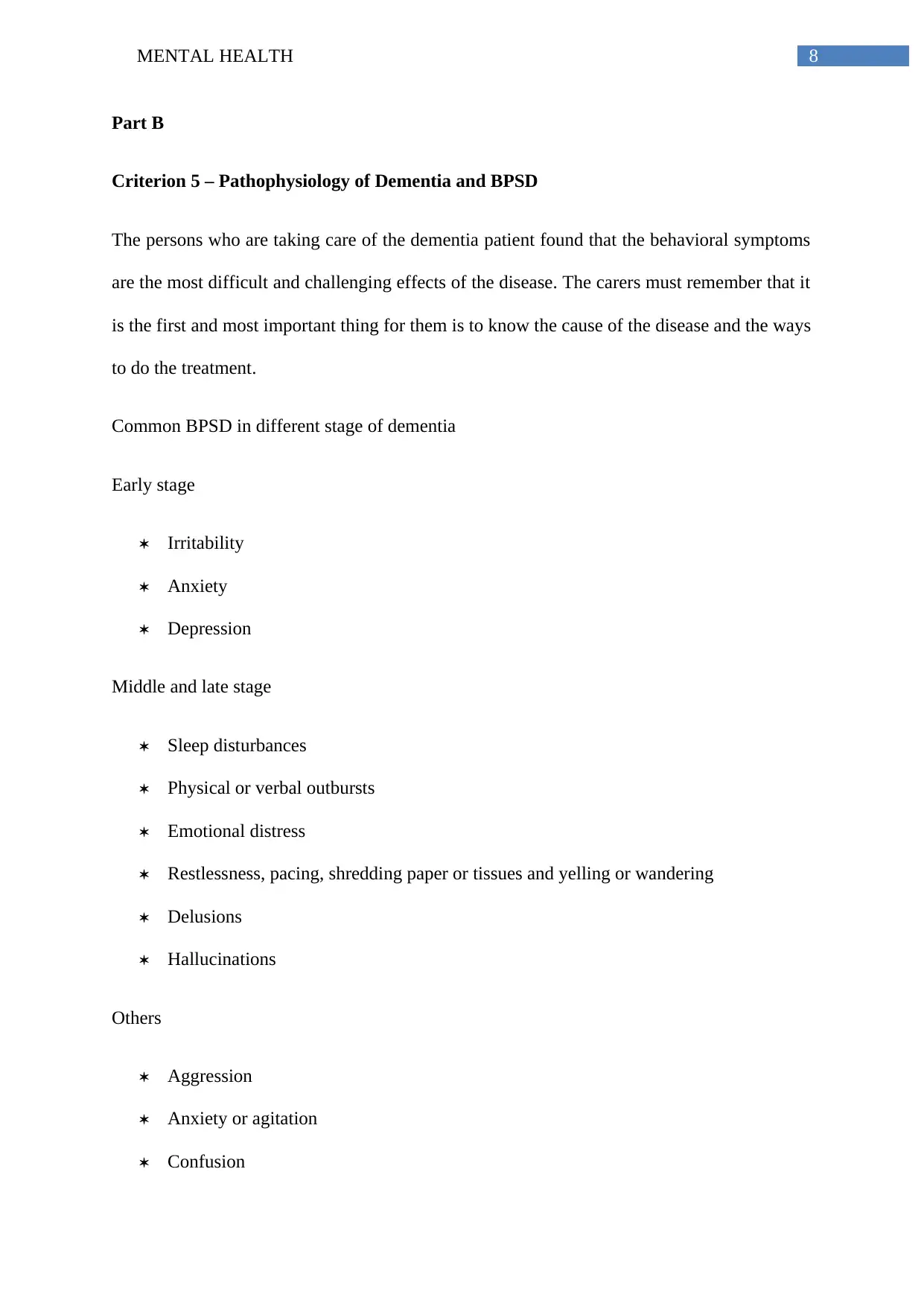
8MENTAL HEALTH
Part B
Criterion 5 – Pathophysiology of Dementia and BPSD
The persons who are taking care of the dementia patient found that the behavioral symptoms
are the most difficult and challenging effects of the disease. The carers must remember that it
is the first and most important thing for them is to know the cause of the disease and the ways
to do the treatment.
Common BPSD in different stage of dementia
Early stage
Irritability
Anxiety
Depression
Middle and late stage
Sleep disturbances
Physical or verbal outbursts
Emotional distress
Restlessness, pacing, shredding paper or tissues and yelling or wandering
Delusions
Hallucinations
Others
Aggression
Anxiety or agitation
Confusion
Part B
Criterion 5 – Pathophysiology of Dementia and BPSD
The persons who are taking care of the dementia patient found that the behavioral symptoms
are the most difficult and challenging effects of the disease. The carers must remember that it
is the first and most important thing for them is to know the cause of the disease and the ways
to do the treatment.
Common BPSD in different stage of dementia
Early stage
Irritability
Anxiety
Depression
Middle and late stage
Sleep disturbances
Physical or verbal outbursts
Emotional distress
Restlessness, pacing, shredding paper or tissues and yelling or wandering
Delusions
Hallucinations
Others
Aggression
Anxiety or agitation
Confusion
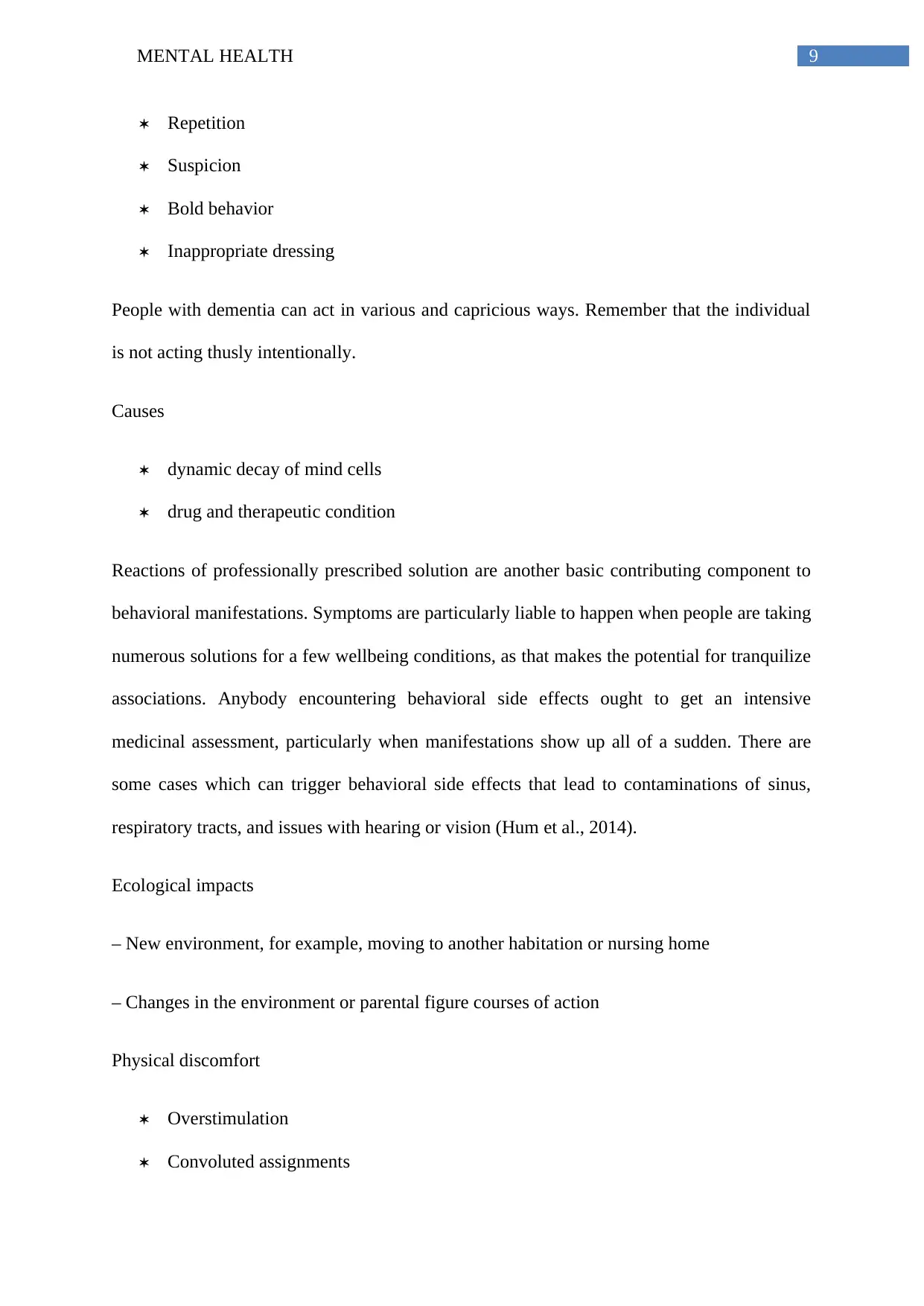
9MENTAL HEALTH
Repetition
Suspicion
Bold behavior
Inappropriate dressing
People with dementia can act in various and capricious ways. Remember that the individual
is not acting thusly intentionally.
Causes
dynamic decay of mind cells
drug and therapeutic condition
Reactions of professionally prescribed solution are another basic contributing component to
behavioral manifestations. Symptoms are particularly liable to happen when people are taking
numerous solutions for a few wellbeing conditions, as that makes the potential for tranquilize
associations. Anybody encountering behavioral side effects ought to get an intensive
medicinal assessment, particularly when manifestations show up all of a sudden. There are
some cases which can trigger behavioral side effects that lead to contaminations of sinus,
respiratory tracts, and issues with hearing or vision (Hum et al., 2014).
Ecological impacts
– New environment, for example, moving to another habitation or nursing home
– Changes in the environment or parental figure courses of action
Physical discomfort
Overstimulation
Convoluted assignments
Repetition
Suspicion
Bold behavior
Inappropriate dressing
People with dementia can act in various and capricious ways. Remember that the individual
is not acting thusly intentionally.
Causes
dynamic decay of mind cells
drug and therapeutic condition
Reactions of professionally prescribed solution are another basic contributing component to
behavioral manifestations. Symptoms are particularly liable to happen when people are taking
numerous solutions for a few wellbeing conditions, as that makes the potential for tranquilize
associations. Anybody encountering behavioral side effects ought to get an intensive
medicinal assessment, particularly when manifestations show up all of a sudden. There are
some cases which can trigger behavioral side effects that lead to contaminations of sinus,
respiratory tracts, and issues with hearing or vision (Hum et al., 2014).
Ecological impacts
– New environment, for example, moving to another habitation or nursing home
– Changes in the environment or parental figure courses of action
Physical discomfort
Overstimulation
Convoluted assignments
Secure Best Marks with AI Grader
Need help grading? Try our AI Grader for instant feedback on your assignments.
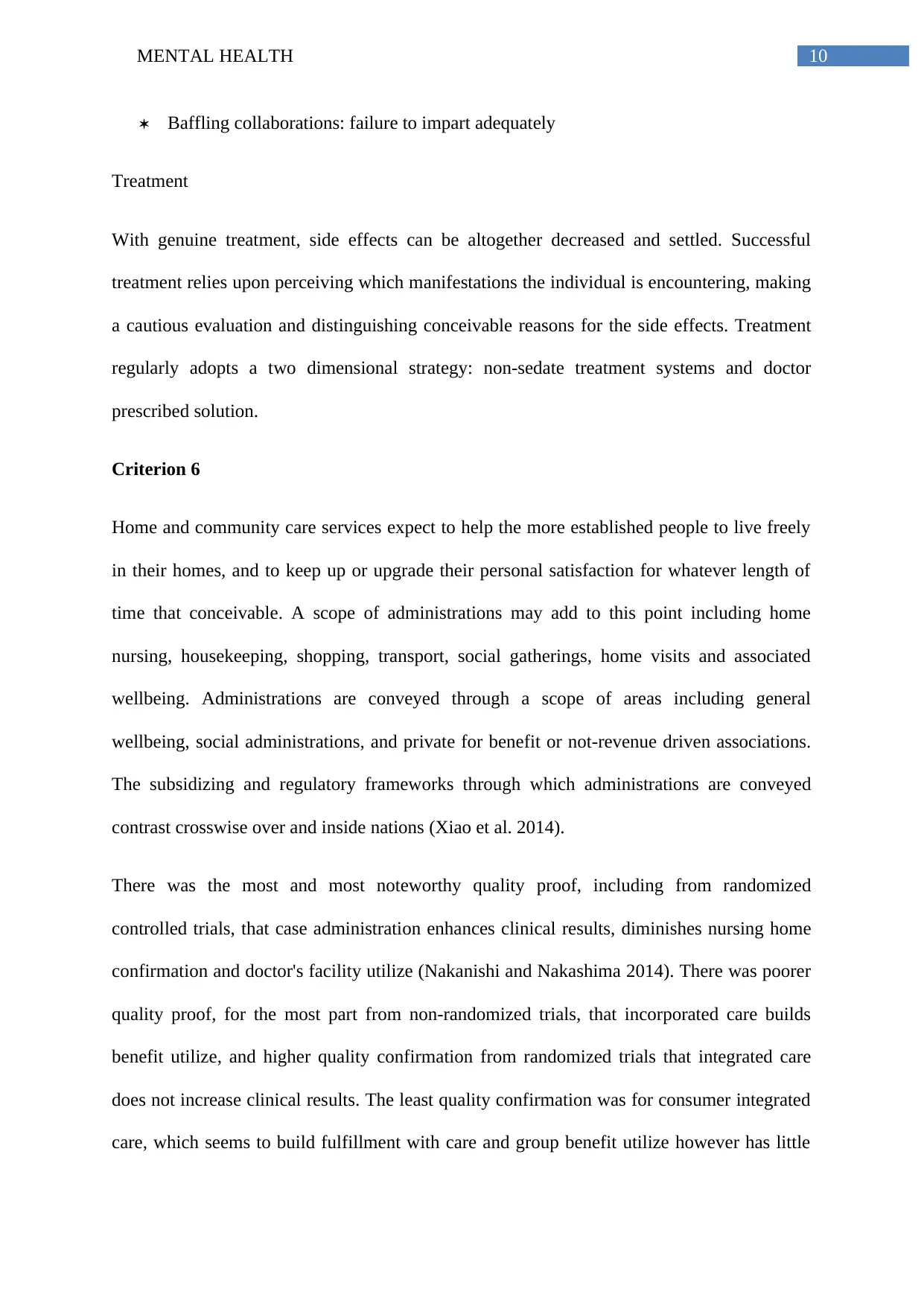
10MENTAL HEALTH
Baffling collaborations: failure to impart adequately
Treatment
With genuine treatment, side effects can be altogether decreased and settled. Successful
treatment relies upon perceiving which manifestations the individual is encountering, making
a cautious evaluation and distinguishing conceivable reasons for the side effects. Treatment
regularly adopts a two dimensional strategy: non-sedate treatment systems and doctor
prescribed solution.
Criterion 6
Home and community care services expect to help the more established people to live freely
in their homes, and to keep up or upgrade their personal satisfaction for whatever length of
time that conceivable. A scope of administrations may add to this point including home
nursing, housekeeping, shopping, transport, social gatherings, home visits and associated
wellbeing. Administrations are conveyed through a scope of areas including general
wellbeing, social administrations, and private for benefit or not-revenue driven associations.
The subsidizing and regulatory frameworks through which administrations are conveyed
contrast crosswise over and inside nations (Xiao et al. 2014).
There was the most and most noteworthy quality proof, including from randomized
controlled trials, that case administration enhances clinical results, diminishes nursing home
confirmation and doctor's facility utilize (Nakanishi and Nakashima 2014). There was poorer
quality proof, for the most part from non-randomized trials, that incorporated care builds
benefit utilize, and higher quality confirmation from randomized trials that integrated care
does not increase clinical results. The least quality confirmation was for consumer integrated
care, which seems to build fulfillment with care and group benefit utilize however has little
Baffling collaborations: failure to impart adequately
Treatment
With genuine treatment, side effects can be altogether decreased and settled. Successful
treatment relies upon perceiving which manifestations the individual is encountering, making
a cautious evaluation and distinguishing conceivable reasons for the side effects. Treatment
regularly adopts a two dimensional strategy: non-sedate treatment systems and doctor
prescribed solution.
Criterion 6
Home and community care services expect to help the more established people to live freely
in their homes, and to keep up or upgrade their personal satisfaction for whatever length of
time that conceivable. A scope of administrations may add to this point including home
nursing, housekeeping, shopping, transport, social gatherings, home visits and associated
wellbeing. Administrations are conveyed through a scope of areas including general
wellbeing, social administrations, and private for benefit or not-revenue driven associations.
The subsidizing and regulatory frameworks through which administrations are conveyed
contrast crosswise over and inside nations (Xiao et al. 2014).
There was the most and most noteworthy quality proof, including from randomized
controlled trials, that case administration enhances clinical results, diminishes nursing home
confirmation and doctor's facility utilize (Nakanishi and Nakashima 2014). There was poorer
quality proof, for the most part from non-randomized trials, that incorporated care builds
benefit utilize, and higher quality confirmation from randomized trials that integrated care
does not increase clinical results. The least quality confirmation was for consumer integrated
care, which seems to build fulfillment with care and group benefit utilize however has little
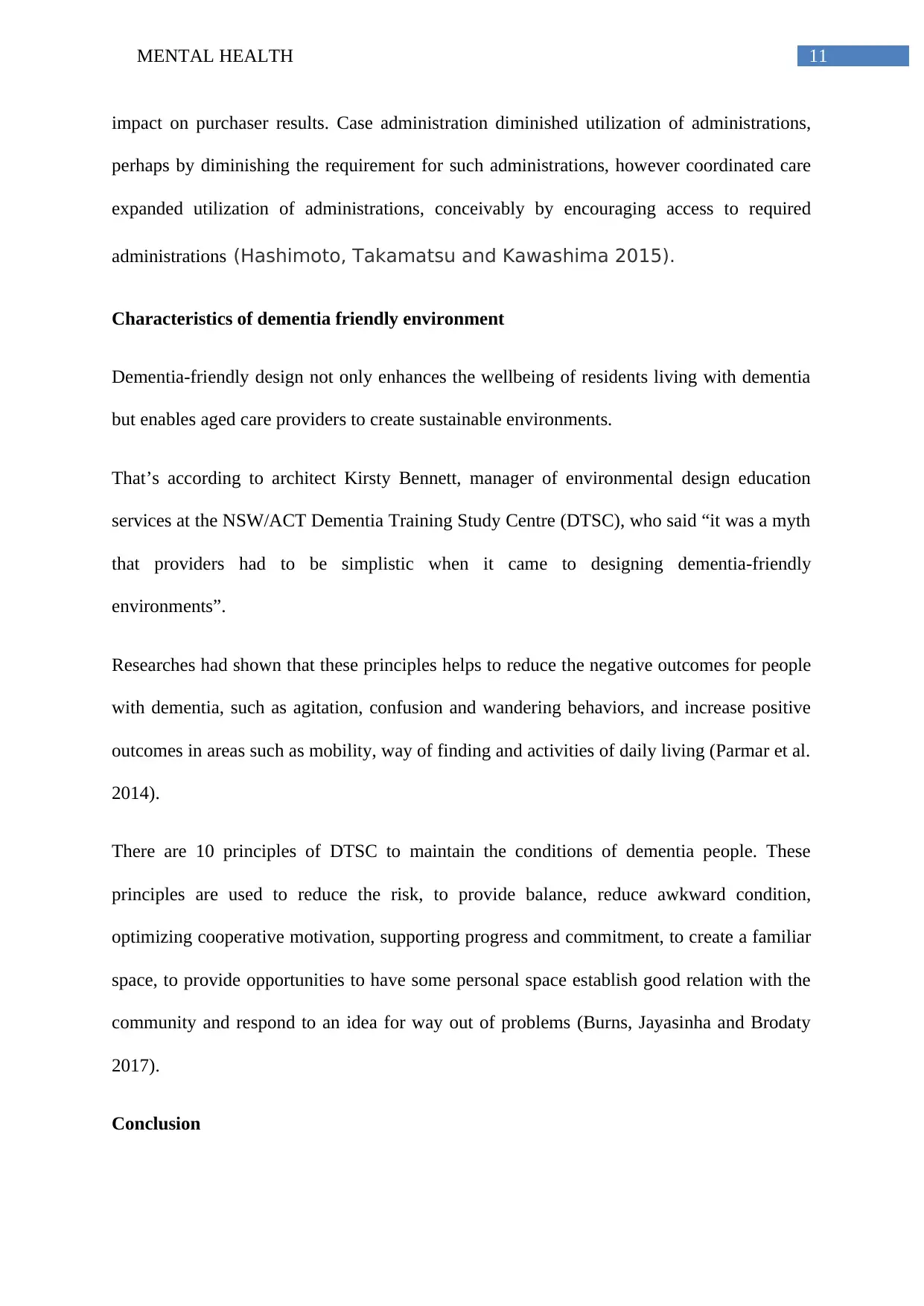
11MENTAL HEALTH
impact on purchaser results. Case administration diminished utilization of administrations,
perhaps by diminishing the requirement for such administrations, however coordinated care
expanded utilization of administrations, conceivably by encouraging access to required
administrations (Hashimoto, Takamatsu and Kawashima 2015).
Characteristics of dementia friendly environment
Dementia-friendly design not only enhances the wellbeing of residents living with dementia
but enables aged care providers to create sustainable environments.
That’s according to architect Kirsty Bennett, manager of environmental design education
services at the NSW/ACT Dementia Training Study Centre (DTSC), who said “it was a myth
that providers had to be simplistic when it came to designing dementia-friendly
environments”.
Researches had shown that these principles helps to reduce the negative outcomes for people
with dementia, such as agitation, confusion and wandering behaviors, and increase positive
outcomes in areas such as mobility, way of finding and activities of daily living (Parmar et al.
2014).
There are 10 principles of DTSC to maintain the conditions of dementia people. These
principles are used to reduce the risk, to provide balance, reduce awkward condition,
optimizing cooperative motivation, supporting progress and commitment, to create a familiar
space, to provide opportunities to have some personal space establish good relation with the
community and respond to an idea for way out of problems (Burns, Jayasinha and Brodaty
2017).
Conclusion
impact on purchaser results. Case administration diminished utilization of administrations,
perhaps by diminishing the requirement for such administrations, however coordinated care
expanded utilization of administrations, conceivably by encouraging access to required
administrations (Hashimoto, Takamatsu and Kawashima 2015).
Characteristics of dementia friendly environment
Dementia-friendly design not only enhances the wellbeing of residents living with dementia
but enables aged care providers to create sustainable environments.
That’s according to architect Kirsty Bennett, manager of environmental design education
services at the NSW/ACT Dementia Training Study Centre (DTSC), who said “it was a myth
that providers had to be simplistic when it came to designing dementia-friendly
environments”.
Researches had shown that these principles helps to reduce the negative outcomes for people
with dementia, such as agitation, confusion and wandering behaviors, and increase positive
outcomes in areas such as mobility, way of finding and activities of daily living (Parmar et al.
2014).
There are 10 principles of DTSC to maintain the conditions of dementia people. These
principles are used to reduce the risk, to provide balance, reduce awkward condition,
optimizing cooperative motivation, supporting progress and commitment, to create a familiar
space, to provide opportunities to have some personal space establish good relation with the
community and respond to an idea for way out of problems (Burns, Jayasinha and Brodaty
2017).
Conclusion
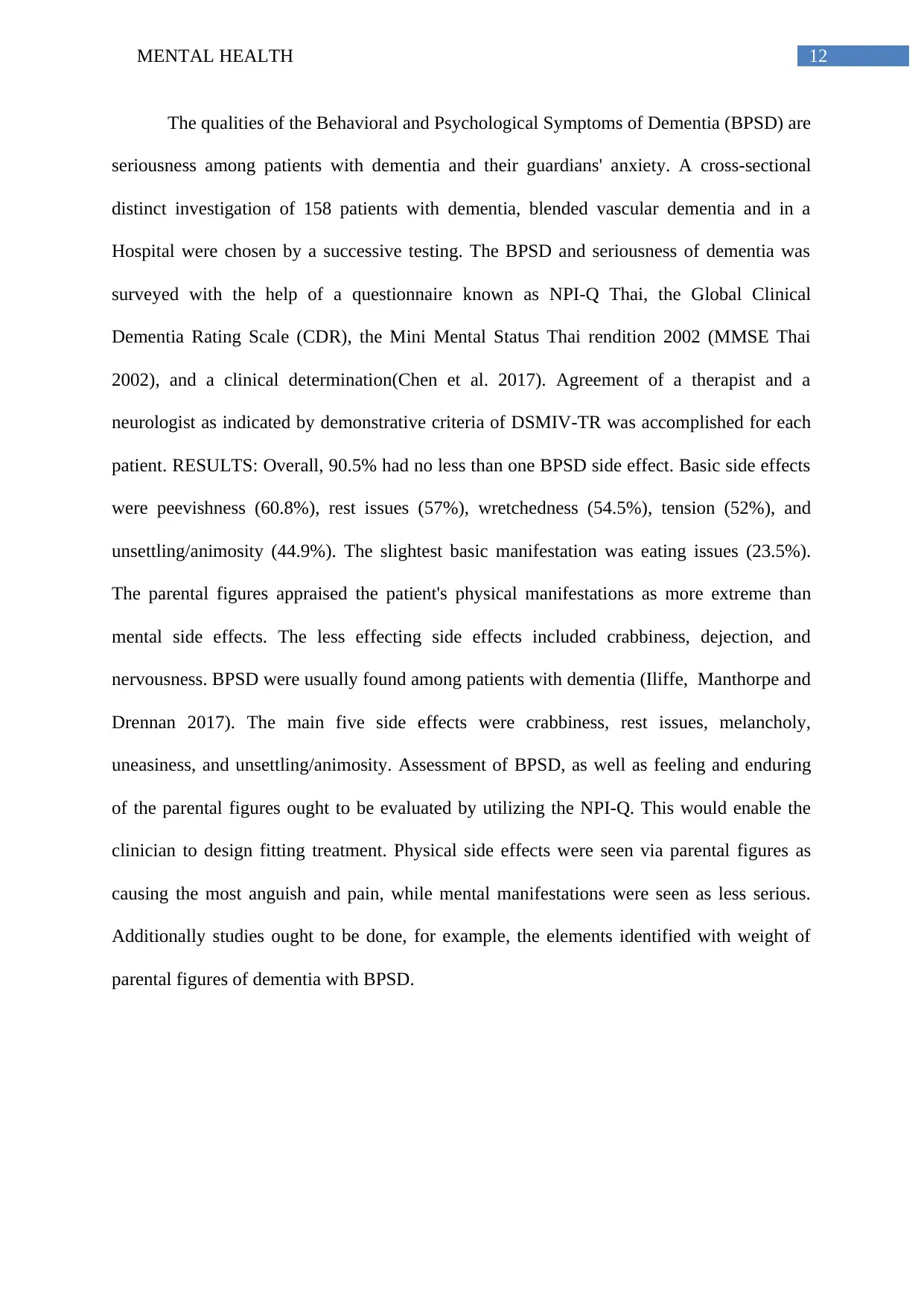
12MENTAL HEALTH
The qualities of the Behavioral and Psychological Symptoms of Dementia (BPSD) are
seriousness among patients with dementia and their guardians' anxiety. A cross-sectional
distinct investigation of 158 patients with dementia, blended vascular dementia and in a
Hospital were chosen by a successive testing. The BPSD and seriousness of dementia was
surveyed with the help of a questionnaire known as NPI-Q Thai, the Global Clinical
Dementia Rating Scale (CDR), the Mini Mental Status Thai rendition 2002 (MMSE Thai
2002), and a clinical determination(Chen et al. 2017). Agreement of a therapist and a
neurologist as indicated by demonstrative criteria of DSMIV-TR was accomplished for each
patient. RESULTS: Overall, 90.5% had no less than one BPSD side effect. Basic side effects
were peevishness (60.8%), rest issues (57%), wretchedness (54.5%), tension (52%), and
unsettling/animosity (44.9%). The slightest basic manifestation was eating issues (23.5%).
The parental figures appraised the patient's physical manifestations as more extreme than
mental side effects. The less effecting side effects included crabbiness, dejection, and
nervousness. BPSD were usually found among patients with dementia (Iliffe, Manthorpe and
Drennan 2017). The main five side effects were crabbiness, rest issues, melancholy,
uneasiness, and unsettling/animosity. Assessment of BPSD, as well as feeling and enduring
of the parental figures ought to be evaluated by utilizing the NPI-Q. This would enable the
clinician to design fitting treatment. Physical side effects were seen via parental figures as
causing the most anguish and pain, while mental manifestations were seen as less serious.
Additionally studies ought to be done, for example, the elements identified with weight of
parental figures of dementia with BPSD.
The qualities of the Behavioral and Psychological Symptoms of Dementia (BPSD) are
seriousness among patients with dementia and their guardians' anxiety. A cross-sectional
distinct investigation of 158 patients with dementia, blended vascular dementia and in a
Hospital were chosen by a successive testing. The BPSD and seriousness of dementia was
surveyed with the help of a questionnaire known as NPI-Q Thai, the Global Clinical
Dementia Rating Scale (CDR), the Mini Mental Status Thai rendition 2002 (MMSE Thai
2002), and a clinical determination(Chen et al. 2017). Agreement of a therapist and a
neurologist as indicated by demonstrative criteria of DSMIV-TR was accomplished for each
patient. RESULTS: Overall, 90.5% had no less than one BPSD side effect. Basic side effects
were peevishness (60.8%), rest issues (57%), wretchedness (54.5%), tension (52%), and
unsettling/animosity (44.9%). The slightest basic manifestation was eating issues (23.5%).
The parental figures appraised the patient's physical manifestations as more extreme than
mental side effects. The less effecting side effects included crabbiness, dejection, and
nervousness. BPSD were usually found among patients with dementia (Iliffe, Manthorpe and
Drennan 2017). The main five side effects were crabbiness, rest issues, melancholy,
uneasiness, and unsettling/animosity. Assessment of BPSD, as well as feeling and enduring
of the parental figures ought to be evaluated by utilizing the NPI-Q. This would enable the
clinician to design fitting treatment. Physical side effects were seen via parental figures as
causing the most anguish and pain, while mental manifestations were seen as less serious.
Additionally studies ought to be done, for example, the elements identified with weight of
parental figures of dementia with BPSD.
Paraphrase This Document
Need a fresh take? Get an instant paraphrase of this document with our AI Paraphraser
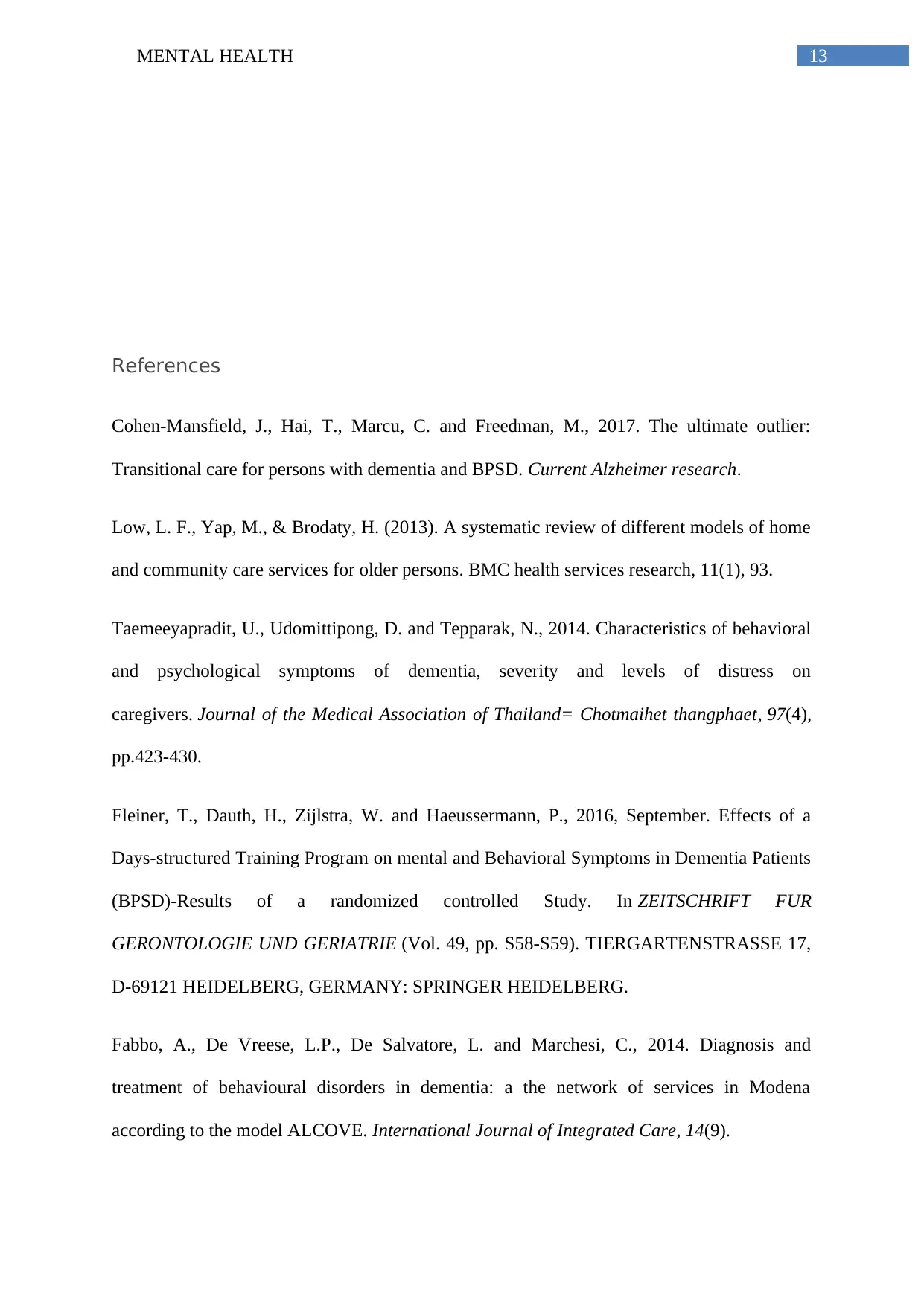
13MENTAL HEALTH
References
Cohen-Mansfield, J., Hai, T., Marcu, C. and Freedman, M., 2017. The ultimate outlier:
Transitional care for persons with dementia and BPSD. Current Alzheimer research.
Low, L. F., Yap, M., & Brodaty, H. (2013). A systematic review of different models of home
and community care services for older persons. BMC health services research, 11(1), 93.
Taemeeyapradit, U., Udomittipong, D. and Tepparak, N., 2014. Characteristics of behavioral
and psychological symptoms of dementia, severity and levels of distress on
caregivers. Journal of the Medical Association of Thailand= Chotmaihet thangphaet, 97(4),
pp.423-430.
Fleiner, T., Dauth, H., Zijlstra, W. and Haeussermann, P., 2016, September. Effects of a
Days-structured Training Program on mental and Behavioral Symptoms in Dementia Patients
(BPSD)-Results of a randomized controlled Study. In ZEITSCHRIFT FUR
GERONTOLOGIE UND GERIATRIE (Vol. 49, pp. S58-S59). TIERGARTENSTRASSE 17,
D-69121 HEIDELBERG, GERMANY: SPRINGER HEIDELBERG.
Fabbo, A., De Vreese, L.P., De Salvatore, L. and Marchesi, C., 2014. Diagnosis and
treatment of behavioural disorders in dementia: a the network of services in Modena
according to the model ALCOVE. International Journal of Integrated Care, 14(9).
References
Cohen-Mansfield, J., Hai, T., Marcu, C. and Freedman, M., 2017. The ultimate outlier:
Transitional care for persons with dementia and BPSD. Current Alzheimer research.
Low, L. F., Yap, M., & Brodaty, H. (2013). A systematic review of different models of home
and community care services for older persons. BMC health services research, 11(1), 93.
Taemeeyapradit, U., Udomittipong, D. and Tepparak, N., 2014. Characteristics of behavioral
and psychological symptoms of dementia, severity and levels of distress on
caregivers. Journal of the Medical Association of Thailand= Chotmaihet thangphaet, 97(4),
pp.423-430.
Fleiner, T., Dauth, H., Zijlstra, W. and Haeussermann, P., 2016, September. Effects of a
Days-structured Training Program on mental and Behavioral Symptoms in Dementia Patients
(BPSD)-Results of a randomized controlled Study. In ZEITSCHRIFT FUR
GERONTOLOGIE UND GERIATRIE (Vol. 49, pp. S58-S59). TIERGARTENSTRASSE 17,
D-69121 HEIDELBERG, GERMANY: SPRINGER HEIDELBERG.
Fabbo, A., De Vreese, L.P., De Salvatore, L. and Marchesi, C., 2014. Diagnosis and
treatment of behavioural disorders in dementia: a the network of services in Modena
according to the model ALCOVE. International Journal of Integrated Care, 14(9).
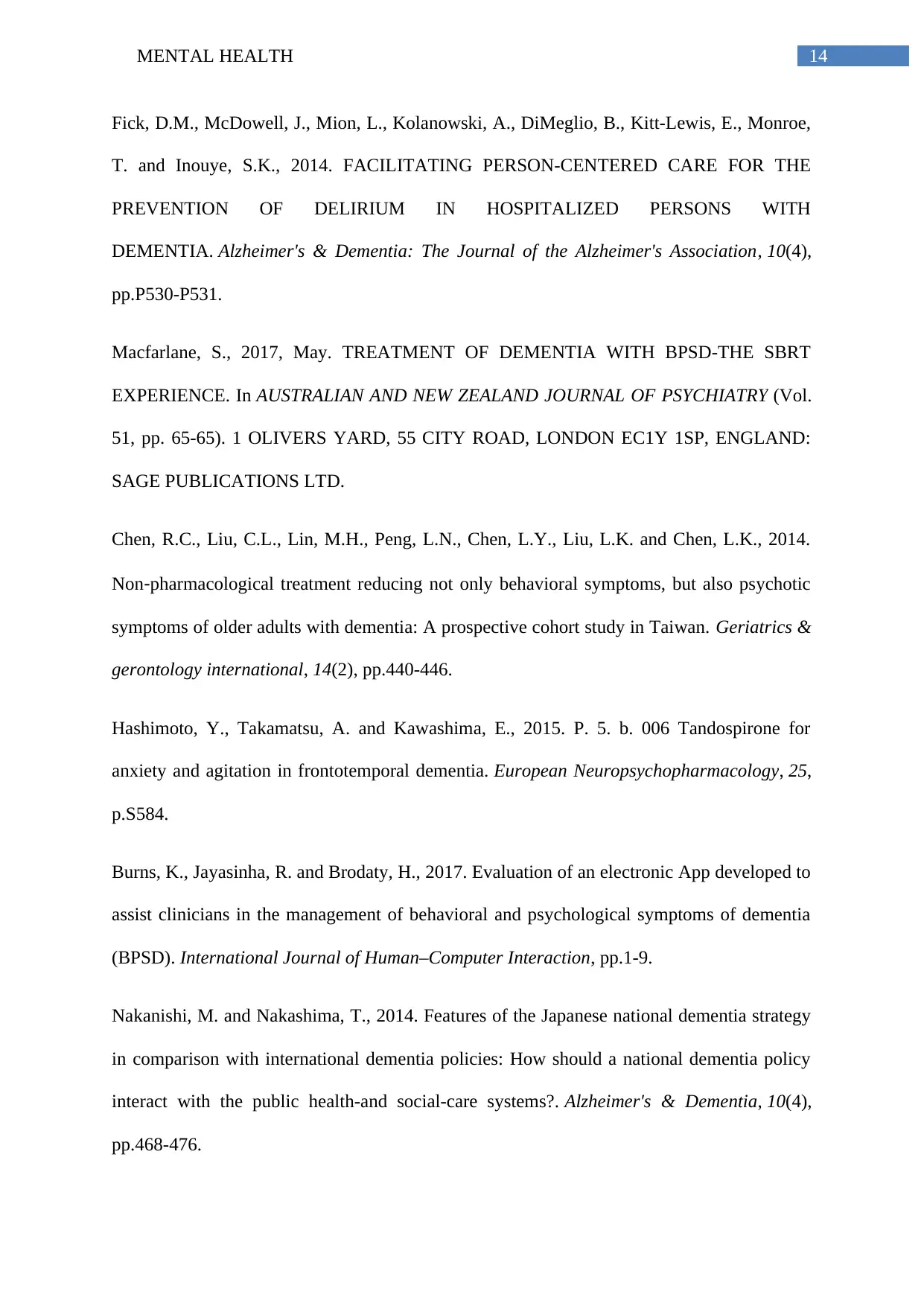
14MENTAL HEALTH
Fick, D.M., McDowell, J., Mion, L., Kolanowski, A., DiMeglio, B., Kitt-Lewis, E., Monroe,
T. and Inouye, S.K., 2014. FACILITATING PERSON-CENTERED CARE FOR THE
PREVENTION OF DELIRIUM IN HOSPITALIZED PERSONS WITH
DEMENTIA. Alzheimer's & Dementia: The Journal of the Alzheimer's Association, 10(4),
pp.P530-P531.
Macfarlane, S., 2017, May. TREATMENT OF DEMENTIA WITH BPSD-THE SBRT
EXPERIENCE. In AUSTRALIAN AND NEW ZEALAND JOURNAL OF PSYCHIATRY (Vol.
51, pp. 65-65). 1 OLIVERS YARD, 55 CITY ROAD, LONDON EC1Y 1SP, ENGLAND:
SAGE PUBLICATIONS LTD.
Chen, R.C., Liu, C.L., Lin, M.H., Peng, L.N., Chen, L.Y., Liu, L.K. and Chen, L.K., 2014.
Non‐pharmacological treatment reducing not only behavioral symptoms, but also psychotic
symptoms of older adults with dementia: A prospective cohort study in Taiwan. Geriatrics &
gerontology international, 14(2), pp.440-446.
Hashimoto, Y., Takamatsu, A. and Kawashima, E., 2015. P. 5. b. 006 Tandospirone for
anxiety and agitation in frontotemporal dementia. European Neuropsychopharmacology, 25,
p.S584.
Burns, K., Jayasinha, R. and Brodaty, H., 2017. Evaluation of an electronic App developed to
assist clinicians in the management of behavioral and psychological symptoms of dementia
(BPSD). International Journal of Human–Computer Interaction, pp.1-9.
Nakanishi, M. and Nakashima, T., 2014. Features of the Japanese national dementia strategy
in comparison with international dementia policies: How should a national dementia policy
interact with the public health-and social-care systems?. Alzheimer's & Dementia, 10(4),
pp.468-476.
Fick, D.M., McDowell, J., Mion, L., Kolanowski, A., DiMeglio, B., Kitt-Lewis, E., Monroe,
T. and Inouye, S.K., 2014. FACILITATING PERSON-CENTERED CARE FOR THE
PREVENTION OF DELIRIUM IN HOSPITALIZED PERSONS WITH
DEMENTIA. Alzheimer's & Dementia: The Journal of the Alzheimer's Association, 10(4),
pp.P530-P531.
Macfarlane, S., 2017, May. TREATMENT OF DEMENTIA WITH BPSD-THE SBRT
EXPERIENCE. In AUSTRALIAN AND NEW ZEALAND JOURNAL OF PSYCHIATRY (Vol.
51, pp. 65-65). 1 OLIVERS YARD, 55 CITY ROAD, LONDON EC1Y 1SP, ENGLAND:
SAGE PUBLICATIONS LTD.
Chen, R.C., Liu, C.L., Lin, M.H., Peng, L.N., Chen, L.Y., Liu, L.K. and Chen, L.K., 2014.
Non‐pharmacological treatment reducing not only behavioral symptoms, but also psychotic
symptoms of older adults with dementia: A prospective cohort study in Taiwan. Geriatrics &
gerontology international, 14(2), pp.440-446.
Hashimoto, Y., Takamatsu, A. and Kawashima, E., 2015. P. 5. b. 006 Tandospirone for
anxiety and agitation in frontotemporal dementia. European Neuropsychopharmacology, 25,
p.S584.
Burns, K., Jayasinha, R. and Brodaty, H., 2017. Evaluation of an electronic App developed to
assist clinicians in the management of behavioral and psychological symptoms of dementia
(BPSD). International Journal of Human–Computer Interaction, pp.1-9.
Nakanishi, M. and Nakashima, T., 2014. Features of the Japanese national dementia strategy
in comparison with international dementia policies: How should a national dementia policy
interact with the public health-and social-care systems?. Alzheimer's & Dementia, 10(4),
pp.468-476.
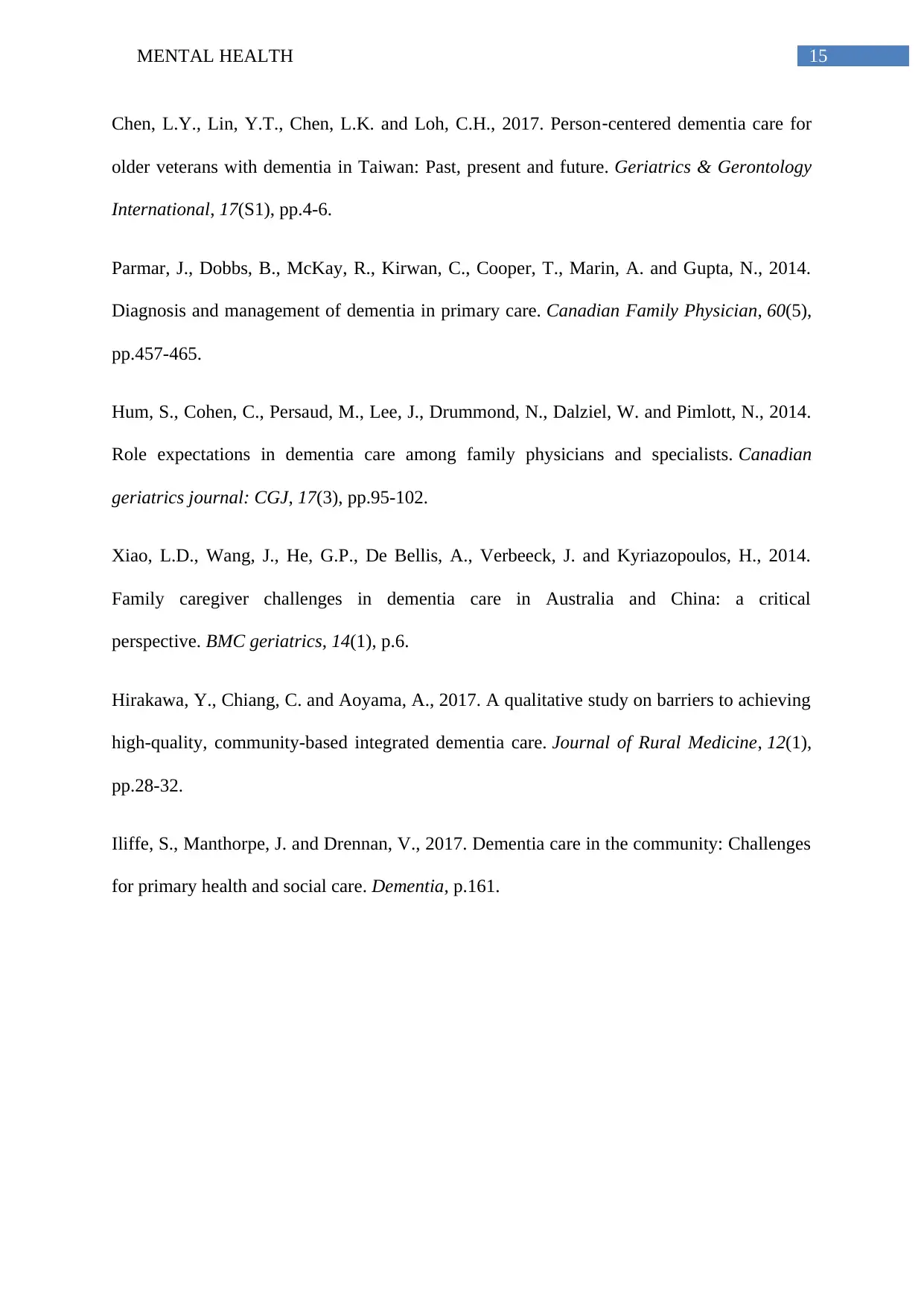
15MENTAL HEALTH
Chen, L.Y., Lin, Y.T., Chen, L.K. and Loh, C.H., 2017. Person‐centered dementia care for
older veterans with dementia in Taiwan: Past, present and future. Geriatrics & Gerontology
International, 17(S1), pp.4-6.
Parmar, J., Dobbs, B., McKay, R., Kirwan, C., Cooper, T., Marin, A. and Gupta, N., 2014.
Diagnosis and management of dementia in primary care. Canadian Family Physician, 60(5),
pp.457-465.
Hum, S., Cohen, C., Persaud, M., Lee, J., Drummond, N., Dalziel, W. and Pimlott, N., 2014.
Role expectations in dementia care among family physicians and specialists. Canadian
geriatrics journal: CGJ, 17(3), pp.95-102.
Xiao, L.D., Wang, J., He, G.P., De Bellis, A., Verbeeck, J. and Kyriazopoulos, H., 2014.
Family caregiver challenges in dementia care in Australia and China: a critical
perspective. BMC geriatrics, 14(1), p.6.
Hirakawa, Y., Chiang, C. and Aoyama, A., 2017. A qualitative study on barriers to achieving
high-quality, community-based integrated dementia care. Journal of Rural Medicine, 12(1),
pp.28-32.
Iliffe, S., Manthorpe, J. and Drennan, V., 2017. Dementia care in the community: Challenges
for primary health and social care. Dementia, p.161.
Chen, L.Y., Lin, Y.T., Chen, L.K. and Loh, C.H., 2017. Person‐centered dementia care for
older veterans with dementia in Taiwan: Past, present and future. Geriatrics & Gerontology
International, 17(S1), pp.4-6.
Parmar, J., Dobbs, B., McKay, R., Kirwan, C., Cooper, T., Marin, A. and Gupta, N., 2014.
Diagnosis and management of dementia in primary care. Canadian Family Physician, 60(5),
pp.457-465.
Hum, S., Cohen, C., Persaud, M., Lee, J., Drummond, N., Dalziel, W. and Pimlott, N., 2014.
Role expectations in dementia care among family physicians and specialists. Canadian
geriatrics journal: CGJ, 17(3), pp.95-102.
Xiao, L.D., Wang, J., He, G.P., De Bellis, A., Verbeeck, J. and Kyriazopoulos, H., 2014.
Family caregiver challenges in dementia care in Australia and China: a critical
perspective. BMC geriatrics, 14(1), p.6.
Hirakawa, Y., Chiang, C. and Aoyama, A., 2017. A qualitative study on barriers to achieving
high-quality, community-based integrated dementia care. Journal of Rural Medicine, 12(1),
pp.28-32.
Iliffe, S., Manthorpe, J. and Drennan, V., 2017. Dementia care in the community: Challenges
for primary health and social care. Dementia, p.161.
1 out of 16
Related Documents
Your All-in-One AI-Powered Toolkit for Academic Success.
+13062052269
info@desklib.com
Available 24*7 on WhatsApp / Email
![[object Object]](/_next/static/media/star-bottom.7253800d.svg)
Unlock your academic potential
© 2024 | Zucol Services PVT LTD | All rights reserved.





